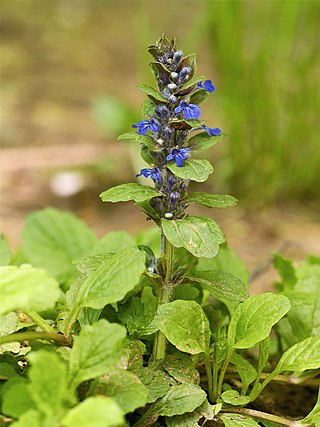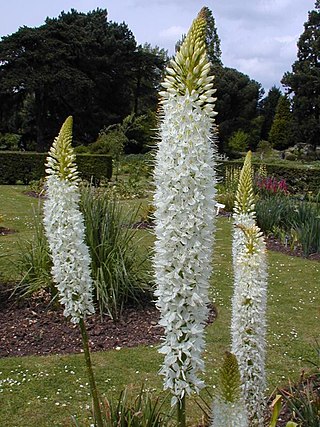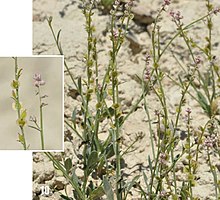
Hyssopus (hyssop) is a genus of herbaceous or semi-woody plants in the family Lamiaceae, native from the east Mediterranean to central Asia as far east as Mongolia. They are aromatic, with erect branched stems up to 60 cm long covered with fine hairs at the tips. The leaves are narrow oblong, 2–5 cm long. The small blue flowers are borne on the upper part of the branches during summer. By far the best-known species is the herb hyssop, widely cultivated outside its native area in the Mediterranean.

Ajuga, also known as bugleweed, ground pine, carpet bugle, or just bugle, is a genus of flowering plants in the Ajugeae tribe of the mint family Lamiaceae. There are over 60 species of annual or perennial, mostly herbaceous plants. They are native to Europe, Asia, Africa, and Australia.

Gagea is a large genus of spring flowers in the lily family. It is found primarily in Eurasia with a few species extending into North Africa and one species in North America.

Lagochilus is a genus of the mint family that contains Turkistan mint.
Oligochaeta is a genus of Asian plants in the tribe Cardueae within the family Asteraceae.

Eremurus is a genus of deciduous perennial flowers in the family Asphodelaceae. They are also known as the foxtail lilies or desert candles. They are native to eastern Europe in, and temperate Asia from Turkey to China, with many species in Central Asia.

Amberboa is a genus of flowering plants in the family Asteraceae, described as a genus in 1832.
Schischkinia is a genus of Asian flowering plants in the family Asteraceae.

-stan has the meaning of "a place abounding in" or "a place where anything abounds" as a suffix. It originated in the Persian language, but is widely used by other Iranian languages as well as the Shaz Turkic languages and other languages historically influenced by Persian. The suffix appears in the names of many regions throughout West, Central and South Asia, and parts of the Caucasus and Russia.

Ungernia is a genus of bulb-forming plants in the Amaryllis family, native to central and south-central Asia Asia.

Eritrichium is a genus of flowering plants in the family Boraginaceae. It contains 78 species. Notable members include Eritrichium howardii and Eritrichium nanum.

Seidlitzia was genus of flowering plants belonging to the family Amaranthaceae, now considered a synonym of genus Soda. It is also in the Salsoloideae subfamily.

The taxonomy of Tulipa places the genus in the family Liliaceae, and subdivides it as four subgenera, and comprises about 75 species.

Juniperus seravschanica is a species of juniper. Common names include Pashtun juniper.
Iljinia is a monotypic genus of flowering plants belonging to the family Amaranthaceae. It only contains one species, Iljinia regelii(Bunge) Korovin ex Iljin

Petrosimonia is a genus of flowering plants belonging to the family Amaranthaceae. It is also in the Salsoloideae tribe.
Sibbaldianthe is a genus of flowering plants belonging to the family Rosaceae. It is also in the Rosoideae subfamily.

Horaninovia is a genus of flowering plants belonging to the family Amaranthaceae. It also belongs to the tribe Salsoleae as well as in the subfamily Salsoloideae.

Hammada is a genus of flowering plants belonging to the family Amaranthaceae. It is also in the Salsoloideae subfamily. Although it is a very unclear and unsorted genus with many species that have later been classed as synonyms.
Turania is a genus of flowering plants in the amaranth family, Amaranthaceae. It includes four species native to Central Asia, ranging from Iran and Afghanistan to Xinjiang and Kazakhstan.















